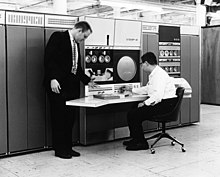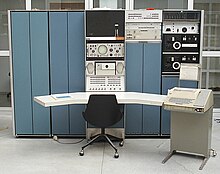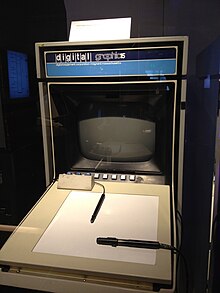
Back معالج البيانات المبرمج Arabic Programmed Data Processor Catalan Programmed Data Processor Czech Programmed Data Processor German Programmed Data Processor Spanish Programmed Data Processor Finnish Programmed Data Processor French PDP HE Programmed Data Processor Hungarian Programmed Data Processor Italian








Programmed Data Processor (PDP), referred to by some customers, media and authors as "Programmable Data Processor,"[1][2][3] is a term used by the Digital Equipment Corporation from 1957 to 1990 for several lines of minicomputers.[4]
The name "PDP" intentionally avoids the use of the term "computer". At the time of the first PDPs, computers had a reputation of being large, complicated, and expensive machines. The venture capitalists behind Digital (especially Georges Doriot) would not support Digital's attempting to build a "computer" and the term "minicomputer" had not yet been coined.[5][6] So instead, Digital used their existing line of logic modules to build a Programmed Data Processor and aimed it at a market that could not afford the larger computers.
The various PDP machines can generally be grouped into families based on word length.
- ^ Montgomery, H. E.; Uccellini, L. W. (October 1985). "VAS Demonstration" (PDF). nasa.gov.
- ^ "New Market Disruption: The DEC Programmable Data Processor". harvard.edu. Archived from the original on 2017-09-15.
- ^ R Belcher (2013). Computers in Analytical Chemistry. p. 153. ISBN 978-1483285627. "The term PDP is an acronym for Programmable Data Processor ... the series was introduced by their manufacturer, Digital Equipment Corporation ..."
- ^ "The History of Digital Equipment Corporation".
- ^ Henderson, Rebecca M.; Newell, Richard G., eds. (2011). Accelerating energy innovation : insights from multiple sectors. Chicago: University of Chicago Press. p. 180. ISBN 978-0226326832.
- ^ Huang, Han-Way (2014). The atmel AVR microcontroller : MEGA and XMEGA in assembly and C. Australia ; United Kingdom: Delmar Cengage Learning. p. 4. ISBN 978-1133607298.